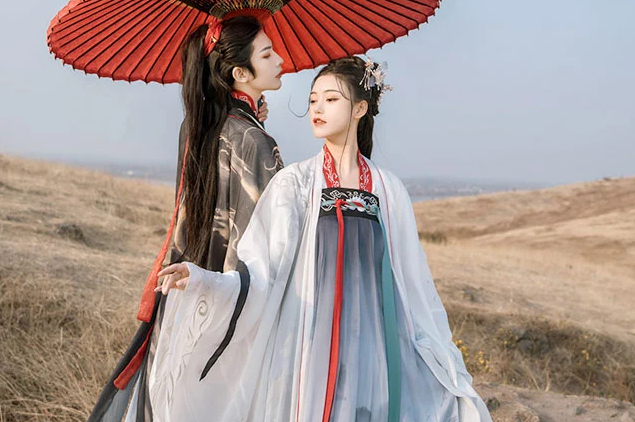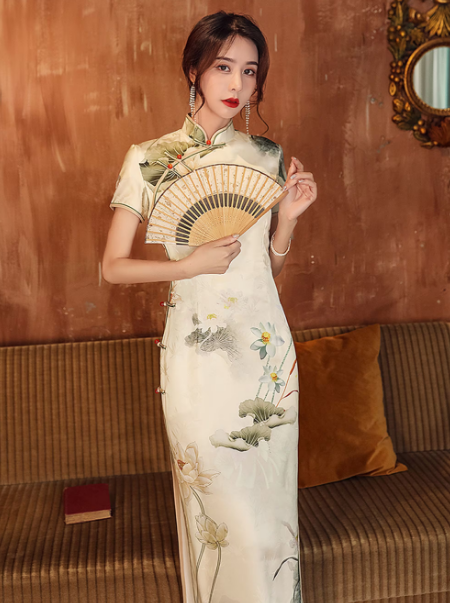Introduction to Traditional Chinese Attire
Chinese traditional clothing reflects the country’s cultural heritage, showcasing its artistry, aesthetics, and social customs. Its origins trace back thousands of years, marked by distinctive styles, fabrics, and colors, varying with dynasties, geography, and social class.
Historical Overview
Chinese attire historically showcased a society’s cultural status and lifestyle. During different eras, from the Shang Dynasty through to the Qing Dynasty, clothing styles evolved significantly. Hanfu, traditional attire of the Han Chinese, is renowned for its cross-collar, wrapping the right lapel over the left. The Tang Dynasty brought about the Tangzhuang, a fusion of styles from ethnic groups along the Silk Road. Hanfu and Qipao or Cheongsam, a figure-hugging dress developed in the 20th century, are particularly symbolic of Chinese fashion history.

Regional Variations and Influences
Traditional Chinese clothing differs vastly across the country’s diverse regions, influenced by climate, local resources, and historical interactions. For instance, the ethnic minorities of Yunnan display vibrant colors and intricate patterns, contrasting with the Han people’s more subdued palette. In the colder northern regions, thicker, padded materials are prevalent, while the south prefers lighter silks and linens. This geographical diversity contributes to a rich tapestry of styles and designs, each with its own story and symbolism.
Hanfu: The Ancient Dress of the Han Dynasty
Hanfu, the classical clothing of the Han people, traces its origins to the Han Dynasty, and it embodies more than just a fashion statement. This attire reflects deep cultural roots and an aesthetic that has influenced subsequent generations.
Evolution and Styles
Hanfu’s evolution mirrors China’s long history. It started with simple draped garments and evolved into complex designs featuring layered robes, wide sleeves, and sashes. Key styles include the “Shenyi” – a one-piece robe that symbolizes unity and modesty, and the “Ruqun” – a combination of a blouse and a skirt, often worn by women. Each style differs in fabric, color, and decoration, indicating the wearer’s age, season, and occasion. Hanfu styles have continuously adapted, seeing a resurgence in modern fashion with both traditional and contemporary twists.
Cultural and Symbolic Significance
Hanfu goes beyond being mere clothing; it represents a philosophy of etiquette, harmony, and respect. Colors in Hanfu often held specific meanings, with yellow reserved for the emperor and red symbolizing good fortune and joy. The attire also plays a crucial role in traditional festivals, weddings, and tea ceremonies, reasserting its cultural significance. As an emblem of Chinese identity and pride, Hanfu not only showcases China’s rich past but also influences contemporary perspectives on beauty and elegance.
Qipao/Cheongsam: The Iconic Body-Hugging Dress
The Qipao or Cheongsam stands out as a symbol of Chinese femininity and elegance. Originating from the Qing Dynasty, this tight-fitting dress has evolved remarkably and continues to fascinate both in China and globally.
Origins and Development
Qipao began as a loose, long robe and underwent significant transformation to become the form-fitting dress known today. Its early form was influenced by Manchu nobility’s attire and was traditionally made of silk, featuring a high neck and a straight skirt. Throughout the 20th century, especially in Shanghai, this garment evolved, becoming shorter and more form-fitting, reflecting Western fashion influences. The changes in its design have made the Qipao a statement piece that accentuates grace and sophistication.
Modern Adaptations and Global Influence
The Qipao has transcended borders and times, adapting to modern fashion trends while maintaining its traditional essence. Contemporary designers often experiment with new fabrics, patterns, and cuts, making the Qipao relevant and stylish for today’s wear. Its influence extends to high fashion runways, Hollywood red carpets, and international cinematic pieces. The dress has also sparked debates and reflections on cultural identity, femininity, and the fusion of Eastern and Western fashion aesthetics. The Cheongsam‘s global presence underscores its unique blend of tradition, modernity, and cultural interplay.
Tangzhuang: The Revival of Tang Dynasty Fashion
Tangzhuang, a modern adaptation of traditional clothing from China’s Tang Dynasty, has seen a revival as a symbol of Chinese cultural pride and heritage. This style, known for its bold colors and elaborate designs, links past to present in Chinese fashion.
Design Characteristics
Originally inspired by the attire of the Tang Dynasty, Tangzhuang typically features straight collars and a series of symmetrical designs. It often incorporates silk fabric, embroidered patterns, and vivid colors, reflecting the Tang Dynasty’s prosperity and openness to foreign influences. Unlike the body-hugging Qipao, Tangzhuang offers a more relaxed fit, suitable for a wide range of body types. It often serves as a canvas for showcasing traditional Chinese motifs like dragons, phoenixes, and lotuses, embodying both elegance and cultural richness.
Contemporary Uses and Celebrations
Today, Tangzhuang enjoys popularity during significant events such as the Lunar New Year, traditional festivals, and family gatherings. It’s not uncommon to see it worn by leaders and citizens alike during important national events, signifying unity and a deep respect for cultural roots. This attire also appears in international contexts, like diplomatic meetings and cultural exchange events, serving as a symbol of Chinese identity and diplomacy. The widespread use of Tangzhuang highlights an ongoing interest in and respect for China’s historical costume heritage in the modern era.
Ming-Style Clothing: Resurgence in Popular Culture
Ming-style clothing, known for its elegance and historical significance, has experienced a resurgence in popular culture, becoming a symbol of Chinese heritage and traditional aesthetics.
Key Features and Materials
Ming-style clothing, deriving from the Ming Dynasty (1368–1644), is famous for its straight lines and minimalistic design, contrasting with the more ornate styles of other periods. This style often includes stand-up collars and wide sleeves and features the use of materials like silk and brocade. Colors play a significant role, with each symbolizing different aspects of society — blue for commoners, red for festive occasions, and yellow traditionally reserved for the emperor. The attire might display intricate patterns, including floral designs, which were not only decorative but also symbolic.

Representation in Media and Arts
The renewed interest in Ming-style clothing is evident in movies, television dramas, and stage performances, where such costumes help recreate historical scenes with authenticity and vibrancy. This fashion resurgence has also influenced contemporary art and design, inspiring modern interpretations and collections. Additionally, with the global spread of Chinese pop culture, Ming-style clothing has started capturing the imagination of international audiences, contributing to a broader understanding and appreciation of Chinese historical fashion.
The Future of Traditional Chinese Clothing
The future of traditional Chinese clothing looks promising, blending rich heritage with contemporary fashion, and adapting to the changing tastes and global trends of the 21st century.
Fusion with Modern Fashion
The fusion of traditional Chinese clothing with modern fashion is creating exciting, innovative styles appealing to a diverse, global audience. Designers are incorporating elements of traditional attire, such as patterns, fabrics, and cuts, into modern clothing. This blend not only rejuvenates traditional styles but also pushes the boundaries of modern fashion design. The emergence of hanfu-inspired streetwear, modernized Qipaos, and Tangzhuang-influenced formal wear showcases a growing trend where heritage meets modernity, catering to both fashion and cultural expression.
Preserving Heritage in the 21st Century
Preserving the heritage of traditional Chinese clothing in the 21st century involves both conservation and education. Museums, cultural programs, and fashion institutions play key roles in this, showcasing historical garments and hosting events to educate the public about the cultural significance of these styles. Moreover, with the use of digital media and online platforms, there is a renewed interest and accessibility to the rich history of Chinese fashion. Efforts in digital archiving, online exhibitions, and interactive experiences ensure that the legacy of traditional Chinese clothing not only survives but thrives in the digital age.